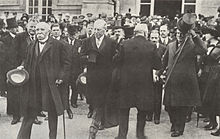Little Treaty of Versailles
Press, 1998, ISBN 0-521-58070-6, Google Print, p.537[1][2] Poland regained independence as the Second Polish Republic, after 123 years of partitions, in the aftermath of the First World War.
The victorious powers decided that due to significant non-Polish minorities in areas claimed by Poland (which historically controlled many Lithuanian and Ruthenian territories under the Polish–Lithuanian Commonwealth and would likely inherit a substantial German minority within its new borders) and the ongoing civilian strife caused by the local wars (in particular the Polish-Ukrainian War of 1918-1919 and Polish-Soviet War of 1919-1920), Poland had to sign the treaty in exchange for Polish independence and for Poland to sign the peace treaty with Germany (the Article 93 of the Treaty of Versailles stated that: "Poland accepts... provisions... to protect the interests of inhabitants of Poland who differ from the majority of the population in race, language, or religion").
The Polish government declared its support for "total and complete protection of life and freedom of all people regardless of their birth, nationality, language, race or religion" (Article 2) and religious tolerance (Article 7 which stated that "difference of religion, creed, or confession shall not prejudice any Polish national in matters relating to the enjoyment of civil or political rights, as for instance the admission to Public employment, functions and honors, or the exercise of professions and industries").
Provisions of the treaty "were obligations of international importance and were guaranteed by the League of Nations".
Difference of opinions "in legal or actual matters" between Poland and any of the western powers or any of the members of the League of Nations Council, which would result from provisions of the treaty was to have an international character (Article 12).
